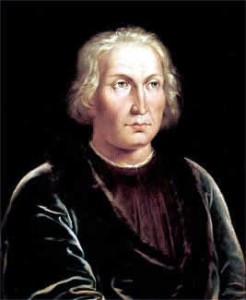By Miguel Pérez
Hidden Hispanic Heritage
To most Spaniards, Christopher Columbus rests where he belongs: in the Gothic Cathedral of Santa Maria, in Seville, Spain, the city from where he set sail for the New World in 1492.
But to most Dominicans, Columbus rests where he wanted to be buried: in Santo Domingo, Dominican Republic, where they have built him an impressive tomb — the cross-shaped monument known as “El Faro a Colon” (the Columbus Lighthouse).
For more than a century, the people of these two countries have bickered about which one actually holds the bones of the great navigator. And now it turns out that both groups could be right.

Columbus’ bones may have been separated, and he could have two legitimate — and well-deserved — burial sites!
Some history: After making four trips to the New World, Columbus died in Villadolid, Spain, May 20, 1506. Yet for many years after his death, his bones kept traveling.
For different reasons, including the fear that his remains would fall into enemy hands, Columbus’ body was exhumed and reburied several times in Spain, the Dominican Republic and Cuba. It led to a terrible mix-up with another set of bones and to an age-old dispute across the ocean conquered by the great navigator.
Although Columbus clearly stated that he wanted to be buried in the New World, at the time of his death, it was determined that there was no church of sufficient stature in the Americas to serve as his tomb. He was buried in a Valladolid monastery and remained there for three years, when he was moved to another monastery in Seville.
But almost 30 years later, Columbus’ daughter-in-law Maria de Rojas y Toledo, the widow of Columbus’ son Diego, was allowed to send the remains of her husband and his father — Columbus — to the cathedral in Santo Domingo.
Historians on both sides of the Atlantic Ocean agree that the remains stayed there for more than two centuries — from 1537 to 1795. But from that point on, there are different theories.
The Spanish say that as they retreated out of the Caribbean islands, they kept taking Columbus’ body with them to avoid leaving him in enemy hands, first away from the French and later the Americans.
Before they ceded the island of Hispaniola to France, the Spanish say they dug up Columbus’ remains from behind the altar in the Santo Domingo Cathedral and sent him to Cuba, which was another Spanish colony. They say he remained buried in the Havana Cathedral for more than a century, until 1898, when the Spanish-American War forced them to exhume him again and send him back to Seville.

However, the Dominicans say that Columbus’ remains never left Santo Domingo. They say the wrong body — perhaps that of Columbus’ son Diego — was sent to Cuba and on to Seville.
That’s because in 1877, when Columbus’ remains were believed to be in Cuba, another set of Columbus’ bones were found in the Dominican Republic. Workers digging inside the Santo Domingo Cathedral discovered a box containing 13 large bone fragments and 28 smaller ones. The box was inscribed, “Illustrious and distinguished male, don Cristobal Colon.”
Because of that discovery, Spain and the Dominican Republic both have been claiming that they have Columbus for more than 100 years.
But that all was supposed to be over by now, thanks to a group of Spanish researchers who, in 2003, set out to unravel the age-old puzzle of where Columbus is buried — through DNA testing. They persuaded Spanish church authorities to open a crypt and exhume the bronze chest reputed to contain Columbus’ bones, and they sent them — with a police escort — across southern Spain for DNA testing at the University of Granada. They also exhumed two other men: a man thought to be Columbus’ brother and one of Columbus’ sons, Hernando, whose identity has been confirmed. They compared the three men’s DNA.
Yet several years ago, although great expectations had been built among Columbus historians, the researchers came up with inconclusive findings. While they were able to confirm that at least some of Columbus’ remains were buried in Seville, they left open the possibility that Columbus’ bones were divided and that the bones now occupy two graves because the Seville crypt contained only 15 percent of a man’s remains. “There must be other bones in other places,” one of the researchers told reporters.
While giving great evidence to those who argue that Columbus is in Seville, he took the wind out of their sails by explaining that some of Columbus’ bones could be in Santo Domingo.
Unfortunately, the Dominican government has been reluctant to allow DNA testing of the bones in the Columbus Lighthouse. Some Dominican scholars still argue that the bones in Seville could have belonged to another Columbus relative and thus still could match the DNA of Columbus’ son and brother.
Yet many other Dominicans say they don’t mind finding out that the real remains of Columbus are in Spain because then they would demand that Columbus be sent back to Santo Domingo, the place where he said he wanted to be buried.
Stay tuned. More than 516 years after he first crossed the Atlantic, Columbus could be coming back again.


